November 5, 2018
Five of the Best Activities in the Great Smoky Mountains
Today’s guest blogger http://www.trip101.com shares five of the best activities to enjoy in the Great Smoky Mountains.
Perhaps the most renowned mountain range in North America, the Great Smoky Mountains border North Carolina and parts of Tennessee, and offer a virtually unlimited selection of world class outdoor activities. Opportunities abound across the “Smokies,” an iconic portion of the Appalachian Mountains, where diversified forest ecosystems thrive among untouched and protected spaces alike. From spruce-fir forests to river valleys, the Great Smoky Mountains offers a proven solution for outdoor adventure in the American southeast. Check out our top five activities worth pursuing in the Smoky Mountains, to fill your travel itinerary with easy, lifelong memories.
1. Clingmans Dome
Dedicated hikers and lovers of awe-inspiring sights and sounds will fall easily in love with Clingmans Dome. Welcome to the highest mountain peak in all of the Smoky Mountains, with an elevation of more than 6,600 feet. Venture to the peak of this coniferous environment, for sweeping, uninterrupted
panoramas of the surrounding landscapes, together with a simply unmatched sense of accomplishment.
Clingmans Dome is halfway in North Carolina and halfway in Tennessee, and provides hours of hiking enjoyment to dedicated travelers. Drive Clingmans Dome Road, and then take to a rather steep pathway up to the summit itself, fitted with an observation tower for extended viewing enjoyment. When visibility is at its best from the top of Clingmans Dome, you can see for more than one hundred miles in all directions, and into seven individual states. Take in a picture-perfect sunrise or sunset from the peak, and cross-country ski to the destination come wintertime.
2. Cades Cove
Located in Tennessee, well within the confines of the Great Smoky Mountains National Park, Cades Cove qualifies as a staple site in the southeastern portion of the United States. The original home to decades-old settlers, Cades Cove is today beloved for its easy access and scenic wildlife surroundings. The historical element of the site alone is enough to satisfy qualifications for the National Register of Historic Places.
A geological “limestone window” defined by dated erosion, Cades Cove is home to rock formations that are more than 400 million years old. Take note of the fact that you must plan ahead if you plan on visiting Cades Cove, given the fact that it is the single-most visited location within the confines of the National Park itself. Home to Cherokee natives, European settlers and now generations of satisfied travelers, Cades Cove offers the unique synthesis of panoramic landscapes and educational immersion alike.
3. Mount Le Conte
For a truly unique Smoky Mountains experience, you need to stop by Mount Le Conte. The pride of Sevier County, Mount Le Conte offers you access to the highest peak housed entirely within the state of Tennessee. Better yet, on the way to the summit you will have ample opportunities to experience more than 5,000 feet worth of forest. The sandstone and the shale that comprise large portions of the
mountain are easily 450 million years old, if not more.
Annual snowfall at Mount Le Conte totals nearly forty inches per year, so if you plan on visiting this site during the winter you would be advised to dress accordingly. Interestingly, Mount Le Conte is also renowned for its lodge near the summit itself, so if you’re looking for some award-winning hospitality along your way to the mountain’s peak, that’s an opportunity worth pursuing. If you spot a train of llamas trekking alongside of you, don’t be alarmed: llamas deliver supplies to the lodge three times a week during peak operational months. Intermediate hiking conditions and frequent opportunities for photos make the hike up Mount Le Conte worth every second of your investment.
4. Andrews Bald
From the bottom of the mountain to the summit, you can expect an elevation gain of nearly 900 feet, coupled with lasting opportunities for photos and fresh, outdoor air alike. If you’re looking to reach Andrews Bald, you’re going to want to embark on the nearby Forney Ridge Trail, which eventually delivers you to your destination. Well-maintained hiking endeavors and stone steps pave the way to the summit itself, part of a park-wide manicured effort to keep this location easily accessible to all guests.
Andrews Bald is the destination for you if you’re looking to bring the entire family along for the ride. Again, this hike is an all-time favorite among dedicated Smoky Mountains hikers, so you’re going to want to get an early start, and prepare to accommodate other hikers en route to Andrews Bald itself. All in all, the hike’s popularity witnesses to its worth, as a family-friendly, worthwhile endeavor in the Great Smoky Mountains.
5. Roaring Fork
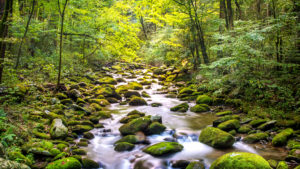
Water stream flowing along the Roaring Fork Motor Nature Trail in the Great Smoky Mountain National Park
With a name like Roaring Fork, you know the experience is worth your investment. A stream that cuts through the Great Smoky Mountains in the Volunteer State, Roaring Fork today is the home of both a historic district and a nature trail of the same name. Straight from the Little Pigeon River, the Roaring Fork stream is a must-see in the Great Smoky Mountains. Take the trail direct to the stream, along the way experiencing waterfall background, ample opportunities for relaxation and the chance to take life at a pace comfortable for you. Activities include touring historic sites. Historically preserved cabins, mills and more will greet satisfied hikers upon arrival, making Roaring Fork an ideal outing, especially for those individuals looking for a quick immersion into local lore.
The Great Smoky Mountains Abound with Family-Friendly Activities
No matter the corner of the Great Smoky Mountains in which you elect to spend your time, the massive acreage allows you to capitalize on authentic outdoor adventure, at a moment’s notice. From the waterfalls of the Andrews Bald trek to the limestone structures of Cades Cove, There’s an outdoor endeavor at the Great Smoky Mountains that can comfortably accommodate anyone’s individual preferences. Provide the entire family with the outing at the Great Smoky Mountains that they deserve, with any one of these five activities virtually guaranteed to deliver lifelong memories outdoors in Tennessee and North Carolina! If you are looking for more destination guides and accommodation reviews, hotels and vacation rentals, check out http://www.trip101.com
October 1, 2018
Autumn Activities in the Great Smoky Mountains
The Great Smoky Mountain Association (GSMA) has announced autumn hiking and learning opportunities in our area this October.
Autumn Birding
Both novice and expert birders will find a rich variety of late-season habitats at the Seven Islands State Birding Park in Kodak, Tennessee. The park is on a peninsula nestled in a bend of the French Broad River and features a diverse landscape of aquatic and grassland habitats, hiking trails, and spectacular mountain views. In a single day, birders may see or hear as many as 80 different species! The hike will be conducted on Sunday, October 7 at 8:00 am. Birders can expect to hike no more than 5 miles on trails rated as moderately difficult. To learn more about all the activities in this blog post, please visit http://www.gsmassoc.org.
Another birding opportunity, this one on Monday, October 8 at 8:00 am starts at the Newfound Gap Rockefeller Memorial to seek out high-elevation bird species such as vireos, nesting wood warblers, and flycatchers. After several hours at Newfound Gap, the birders will drive to Clingman’s Dome to follow a nature trail in search of red crossbills, common ravens, and more. This hike is rated moderate and will be about 5 miles in length.
Hiking
If you are in the mood for an easy to moderate hike of about 6 miles, then be sure to go to Mingus Mill in North Carolina on Monday, October 8. The hikers will follow a portion of Mingus Creek. Local hiking enthusiasts will lead the way to Floyd Cemetery and perhaps also to Queen W.H. Cemetery. The hike includes passing the still-operating Mingus Mill which was built in 1886.
As the group goes to the Enloe Slaves Cemetery they will enjoy spotting wildlife activity, late-season wildflowers, and early fall foliage colors.
On Tuesday October 30 you can meet at 8:30 at the Little Brier School in Tennessee. Park volunteer Robin Goddard, dressed in character, will take you back in time to 1881 in the one-room Little Greenbrier schoolhouse. As the hike continues, a professional naturalist will share the cultural history of the Walker family. She will explain the natural resources they needed so the family of 13 could be self-sustaining. They worked in their livestock pastures, fruit orchards, and vegetable fields until the 1960’s. Be prepared to walk about 5 miles on easy to moderate trails.
Autumn is a wonderful time to visit the Great Smoky Mountains. The weather will be perfect for hiking and exploring, and then for enjoying a delightful dinner and cozy accommodation at the Buckhorn Inn.
August 27, 2018
Hikes and Activities in the GSMNP
The Great Smoky Mountains Association has shared some information on upcoming hikes and other outdoor activities.
Upcoming Hikes
Sunday, September 2, 2018, 9:00 a.m. Alum Cave Trail–Great Smoky Mountains National Park, Tennessee. When you hike Alum Cave Trail, you’ll travel the park’s latest Trails Forever success story. What was once a worn path is now a safer, smoother trip along one of the most scenic trails in the Smokies. Join professional guide Liz Domingue to explore the beauty of this trail. The hike is 5 miles and is rated moderate to strenuous.
Saturday, September 22, 2018, 8:30 a.m. Swain County Visitor Center and Museum, Bryson City, North Carolina. History in the Noland Creek Valley runs deep. During the late 1800s and into the early 19002 this remote area was home to farmers and their families. In 1905 the Harris-Woodbury Lumber Company purchased 17,000 acres but spared the Noland watershed from logging operations. Surrounded by natural beauty, Steve Kemp, award-winning author and Smokies historian, will interpret the history and uses of the area. The hike is about 12 miles and is rated moderate to strenuous due to the length.
Other Activities
Monarch Butterfly Tagging: A Citizen Science Program, Cades Cove, Tennessee. The program is being
held at 9:00 a.m. on Saturday, September 22, Sunday, September 30, and Saturday, October 6, 2018. Monarchs are the only known butterfly species to make a true migration in North America. Many of the monarchs we see traveling through East Tennessee are on a 2,000 mile journey to spend winter among forests high in the mountains of Mexico. The Great Smoky Mountains Association monarch tagging program gets you involved by collecting data that will help scientists answer questions about the origins of monarchs that reach Mexico, the timing and pace of the migration, mortality during the migration, and changes in geographic distribution. Plan on 3 miles of hiking that is rated easy.
For more information on these, and other, activities, please visit the Great Smoky Mountains Association at http://www.smokiesinformation.org.
July 23, 2018
Amazing Biodiversity in the Great Smoky Mountains
The term “biodiversity” refers to the variety of plants, fungi, animals, and other organisms that can be found in a particular location. The Great Smoky Mountains is the most biodiverse park in the National Park System. The more than 800 square miles of the park contains more than 19,000 documented species. Some scientists believe an additional 80,000 to 100,000 species may be found here.
What are the Reasons for such Biodiversity?
According to the National Park Service, mountains, climate, and weather are the big reasons. http://www.nps.gov/grsm/learn/nature/index.htm The Smokies are among the oldest mountain ranges in the world. The plant-covered mountains were formed as long as 300 million years ago. Elevations in the park range from 850 to 6,643 feet. This range is similar to what one would find from Georgia to Maine. More than 95% of the park is covered with forest, much of it old-growth. The park is home to 100 species of native trees. The abundant rainfall and high humidity provide good growing conditions. It is interesting to note that the relative humidity in the Smokies in the summertime is about twice that of the Rocky Mountain region.
The north/south positioning of the Appalachian chain allowed the Smokies to become a home for many plants and animals that sought refuge from the glaciers of the last ice age. More than 1,500 flowering plant species have been identified in the Great Smoky Mountains National Park. Scientists report that the park also is home to more than 200 bird species, 68 species of mammals, 67 native fish species, 39 species of reptiles, and 43 species of amphibians.
The University of Tennessee has worked with the Great Smoky Mountains National Park to create the Species Mapper. The Species Mapper uses information from observations and research studies to predict where various species may be found in the Park. As more observations are added to the model, it becomes more accurate.
We will use this blog space to share an occasional series of articles focusing on the amazing biodiversity of our area.
July 9, 2018
Black Bears in the Smokies
The Great Smoky Mountains National Park is a large, protected area where black bears can roam freely. The park service estimates that about 1,500 bears live in the park–that translates to a density of about two of the animals per square mile. Sighting one of these magnificent creatures is a highlight of a vacation, but caution is necessary for the protection of the bear and of the tourist. Bears can live 12-15 years or more in the wild, but those which have had access to human food and garbage have a life expectancy of only half that time.
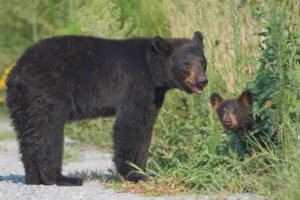
Black bear (Ursus americanus) mother standing in the road with young cub peeking out from the bushes.
Behavior of Bears
Like us, bears are omnivores. Berries and nuts make up about 85% of their diet. Insects and carrion are valuable sources of protein. These creatures have a very keen sense of smell. Feeding bears, or allowing them access to human food and garbage causes a number of problems. It causes them to lose their instinctive fear of humans. Over time this means they may begin approaching people and may become more unpredictable and dangerous. They may begin to pose a risk to public safety and must be euthanized. In other cases they come close to human areas and are hit by cars or become easy targets for poachers. The park service warns us that Garbage Kills Bears!
What Do I Do If I See Bears?
They are beautiful creatures. But remember that they have color vision, a keen sense of smell, are good swimmers and tree climbers, and can run 30 miles per hour. The park service provides a short video to help tourists understand what to do if they see a bear http://www.nps.gov/grsm/learn/nature/black-bears.htm If you do see a bear you should remain watchful and not approach it. Do not allow the bear to approach you. Being too close may promote aggressive behavior from the bear. For these reasons, willfully approaching within 50 yards (150 feet) or any distance that disturbs or displaces a bear, is illegal in the park. Use binoculars or a telephoto lens to view them.
If the bear approaches you, don’t run but rather back slowly away. The bear will probably do the same. If he continues to approach you, change your direction. If he continues, stand your ground and talk loudly or shout at it. Make yourself look as large as possible. Use a stout stick to intimidate the bear. It is very rare that you would be physically attacked, but if so you should not play dead. Fight back aggressively with any available object.
Remember, the goal of bear management is to keep these magnificent animals shy, secretive, and afraid of people.
June 4, 2018
Fishing in the Great Smoky Mountains National Park
Many of our guests are fishing enthusiasts. They find the Buckhorn Inn makes a great base of operations for spending the day on the water and returning home to pampered comfort. Reports are that the fishing is good this spring. Today we welcome guest blogger, CJ Stancil, to give us the latest.
This time of year is a beautiful time to fish in the Great Smoky Mountains National Park. Not only are the trout biting but the scenery is amazing. The Park has abundant species of wild flowers and plant life that are just now coming into peak. Wildlife that call the Smokies home in its half-million acre wilderness are black bear, whitetail deer, turkey and elk.
Area Known for Good Fishing
The Park has nearly 800 miles of fishable waters that hold trout. Wild brown trout, rainbow trout, and native brook trout are the species you will find here.
The trout here make the Great Smoky Mountains National Park one of the country’s most popular fishing destinations. Even a beginner can expect to catch these wild trout. Heavy rain has made the waters rise recently but the forecast is looking better. Cooler temperatures and sunny weather should last most of the week. Dry flies are getting a lot of action. Try running a dry dropper setup. If the water is high and stained, throw an indicator rig. Work combinations like a pheasant tail, pats rubber let, or a squirmy worm. Make sure you are getting the flies down deep and fast. Good luck and tight lines! CJ Stancil
Many of our guests have fished with CJ and report a great experience. You may contact him to book a trip through the Smoky Mountain Angler http://www.smokymountainangler.com or by email [email protected]. CJ also has offered his phone number 931-801-4204. To see some photos of beautiful trout, be sure to follow him on Instagram at @dancewithtrout.
May 15, 2018
Great Sights in the Great Smoky Mountains
Guests often ask us our favorite sights in the area. There are so many! Luckily for us the Smokies Guide Spring 2018 issue includes information on five top visits. http://www.nps.gov/grsm
- NEWFOUND GAP. A “gap” is a low point in a mountain ridge. Newfound Gap is about 16 miles from Gatlinburg. Visitors will see spectacular views and be able to walk along the Appalachian Trail.
The Gap is nearly a mile higher in elevation than the surrounding lower areas so can be significantly cooler. You will see spruce-fir forests and beautiful wildflowers.
- 2. OCONALUFTEE MUSEUMS. A 32-mile drive from Gatlinburg will take you to the Oconaluftee Museums. The free indoor and outdoor museums depict the life of families from the Cherokee to the creation of the national park. The outdoor farm is an agricultural paradise which features older breeds of animals and an heirloom garden. The 2-mile hiking trail begins at the museum and often enables sightings of elk and beaver.
- CADES COVE. In this area you likely will see deer and may also spot bear, coyote, and wild turkey. Historic buildings in this area include a gristmill, several barns, three churches, and many log homes. An 11-mile one-way loop road takes you around the cove. The distance from Gatlinburg is about 27 miles.
- OLD ELKMONT TOWN. This was once a booming logging town. Today you will find a variety of hiking trails that vary from easy to moderate-difficulty. Good trout fishing can be found in the nearby Little River. The restored Appalachian Clubhouse, Spence Cabin, and four other historic buildings offer a peek into bygone days. Elkmont is about 7 miles from Gatlinburg.
- DEEP CREEK. This area has beautiful streams and waterfalls. This is one of the few park areas where bicycles are permitted. The distance from Gatlinburg is about 48 miles.
Share your Favorite Sights with Us!
What are some of your favorite places to visit in eastern Tennessee? Please share your pictures and stories with us at [email protected]. We would love to share your experiences with other members of the Buckhorn Inn family through Facebook and Instagram.
April 3, 2018
Elk Thrive in Great Smoky Mountains National Park
Visitors to the Great Smoky Mountains National Park look forward to spotting our large wildlife–namely bear and elk. We are fortunate indeed to be located near such splendor.
Did you know that once large numbers of elk freely roamed the Appalachian Mountains and eastern United States? Unfortunately, overhunting and destruction of habitat severely lowered their numbers. Conservation groups became concerned that the animals would eventually become extinct. The last of the magnificent beasts disappeared from Tennessee in the mid 1800’s.
In 2001 the National Park Service reintroduced elk to the Great Smoky Mountains National Park. Twenty-five of the animals were moved to the park then, and 27 more were placed here in 2002. The elk (or wapiti) wear radio collars and ear tags to aid conservationists in tracking their range and movements. The herd now numbers as many as 200 animals.
These are the largest animals in the Smokies. The bulls weigh 600 to 700 pounds, measure 7 to 10 feet long, and sport antlers that can measure 5 feet from tip to tip.
Safe Viewing of Elk in the Park
The best times to view these animals are early in the morning and late in the evening. They also are more active after storms or on cloudy days. Most of them are located in the Cataloochee area in the southeastern section of the park, easily accessible from the Buckhorn Inn. This is a lovely area to hike and picnic as well. Always view these wild animals from a safe distance, using binoculars or a camera for close-ups. Be especially careful of calves as there likely is an anxious mother nearby. The males may perceive you as a challenger and charge. The National Park Service offers a short video about safely viewing elk. You may find a link to it at http://www.nps.gov/grsm/learn/nature/elk.htm
During March and April the animals begin to shed their antlers. Please note that it is not legal to remove antlers from the park. The discarded antlers are a rich source of calcium for other wildlife in the park.
February 26, 2018
Hikes to Cemeteries of the Smokies
Did you know that their are roughly 150 cemeteries scattered throughout the Great Smoky Mountains National Park? The land for the park was purchased from families, many of whom lived in this area since the 1800’s. Along with homes, churches, farm buildings, and stone walls, many of their cemeteries are part of the park land. Some are near main trails, others can be found with a map, and a few are slowly becoming overgrown and disappearing.
“Cemeteries of the Smokies” Guidebook
One of the most popular books published by the Great Smoky Mountains Association is “Cemeteries of the Smokies”. The book provides directions to all 152 graveyards in the park. For each site, the book provides a complete listing of burials and dates, kinship links, and epitaphs. There is also an index of local family names. These historic spots provide a tangible link with our area’s past. They can provide us with insight into customs, religious beliefs, cultural and ethnic influences, and the community development of our ancestors.
The Hiking 101 program sponsored by the Great Smoky Mountains Association takes its inspiration from this book. They have designed 12 guided hikes and a bus tour to take participants to the sacred spaces within the boundaries. These hikes are not all easy, but the hiker is rewarded by coming to know those who lived and died here, and remain buried in lost graves, family plots, and in church burial grounds. Registration for these hikes is now open. For program details and to register, please visit http://www.smokiesinformation.org.
The hikes are limited to 15 individuals each and run from March 17 through October 16 2018. It is important to note that the Park Service frowns on creating “rubbings” of inscriptions on the headstones. The pressure needed to make a clear rubbing can damage the surface. The Great Smoky Mountain Association asks for your help in ensuring the preservation of these plots for future generations.
September 25, 2017
Fall in the Great Smoky Mountains National Park
Fall is a great time to be in eastern Tennessee! The experts are predicting a magnificent display of colors this year and the Buckhorn Inn is so convenient to the Park. The Great Smoky Mountains National Park rangers have planned many free activities to help you enjoy the park. Here are some of our favorites!
Evening Campfire
A ranger is available to tell stories and histories around the campfire from 7:30 to 8:30 pm in the Elkmont Campground. The campfire program runs on Friday and Saturday evenings from September 16 through October 28.
The “Good Ol’ Days”
Walk the Mountain Farm Museum with a ranger and learn about the early settlers in this area. The Museum is located by the Oconaluftee Visitor Center. This event is available every Saturday at 10:30 am from September 16 through October 28.
Porters Creek Hike
Join a ranger in “our own backyard” to engage in an eye-opening exploration of how much, and how little, things have changed over the years in the Greenbrier Cove area. The hike is conducted on Wednesdays and Saturdays. Hikers should meet at the Porters Creek trailhead.
Fall Amble
This is one of our favorite ways to take in all the beautiful colors of fall in the Great Smoky Mountains National Park. Locations for this hike vary as the ranger will take you to the elevation where the leaves currently are at their peak. The hikes begin at 10:30 and are classified as moderately difficult. This hike is available on Sundays and Wednesdays from September 17 through October 25.
School Days at Little Greenbrier
Discover what it was like to live in a mountain community and to attend a one-room school house. This trip back in time happens every Tuesday through October 24 at 11 am and 2 pm. Meet at the Little Greenbrier Schoolhouse near the Metcalf Bottoms picnic area.
All of these events, and many more, are detailed at the National Park Service website. Please visit http://www.nps.gov/grsm/planyourvisit/calendar. We look forward to seeing you this fall!




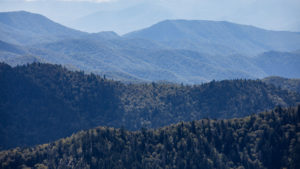
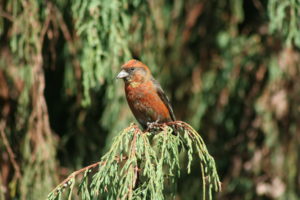




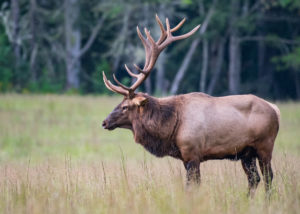



Gatlinburg Weather
Click for weather forecast